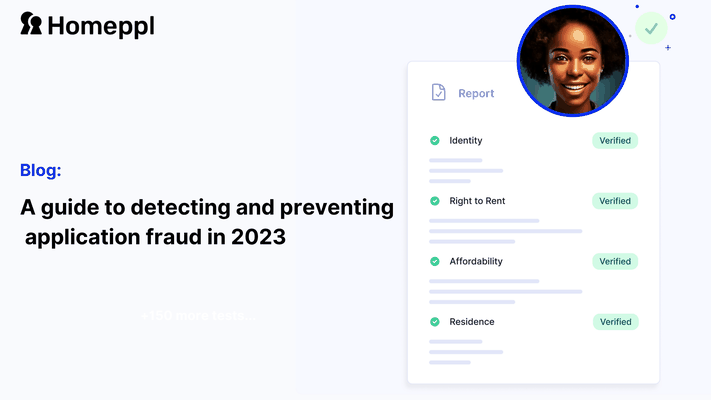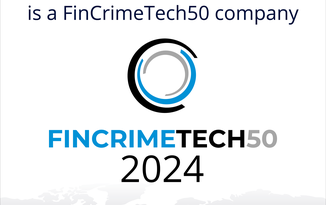Table of contents:
What is application fraud?
Why does application fraud thrive in financial services?
What is the most common type of application fraud?
In what industries does application fraud most likely occur?
Why is there a renewed focus on application fraud?
How can organisations level up in their detection of application fraud?
What considerations should be made when building a new framework for fraud prevention?
What is synthetic identity fraud and where is its place in banking?
Action points financial companies can take to prevent and deter application fraud
Fraud technologies available
What is application fraud?
Application fraud, also known as form fraud, refers to the act of providing false or manipulated information during the application process for a financial product, such as a mortgage, loan, a rental agreement for a property, a business loan, car financing, or bank account, to deceive for financial gain or financial access.
This fraud can occur through first-party actions, where the customer falsifies information, or through third-party actions, where criminal gangs use false or stolen identities. Despite varying sizes and scales, application fraud is a significant challenge and can result in lost business, defaulted loans, and compliance fines.
The cost of application fraud in the insurance industry alone is estimated to be over £2 billion annually in the UK. When considering the potential for fraud across all financial products and industries, especially during times of economic hardship when people may be more likely to resort to fraudulent methods, the scope of the problem becomes even more frightening.
Why does application fraud thrive in financial services?
With the wave of digitisation, and the requirement for speed and ultimate customer satisfaction when dealing with financiers, online companies have become ever more inclined to approve applications quickly to increase the number of new users. This is often used as a metric for growth. This can lead to less strict risk management practices. However, this can be a detrimental business strategy. It can result in lost business, loans given to individuals who will default, and compliance fines for not following Know Your Customer (KYC) or Anti-Money Laundering (AML) regulations. When you combine this consumer demand for speed and satisfaction with the fact that many financial companies still have manual ops processes where humans, subject obviously to human error, are checking applications in line with KPIs that incentivise speed, companies end up losing massive amounts of revenue to fraud loss.

In 2023, concerned consumers desire quick and accurate credit decisions for a variety of financial products, including Buy Now Pay Later repayment options, credit cards, mortgages, and auto lending. Financial institutions that are unable to provide this service may fall behind in the market. However, it is important to strike a balance between speed and accuracy to avoid defaults. Smaller institutions need to diversify and expand their lending portfolio to be able to withstand financial downturns and meet consumer demands for quick digital lending services offered by fintechs. Banks and credit unions that rely on outdated manual credit processes may be at a greater risk of lending to individuals or companies who may be unable to repay loans during recessions, which can have serious consequences for small institutions. Despite this, lending is crucial for their survival in the market.
What is the most common type of application fraud?
Historically, identity theft made up the vast proportion of application fraud cases where criminals would steal personal information from others to open a banking account or authorise a transaction in a victim’s name. However, this is hard. It takes a huge amount of planning and requires the ‘know-how’ and tech skills of an expert financial criminal. With the cost of living crisis in full swing, the major increases in application fraud come from real individuals attempting to hide their credit files or inflating their financial position to gain access to financial products.
Here's an example of how we caught an application faking their address to either commit fraud or hide bad credit:
Homeppl have concluded that 91% of the fraud cases they picked up in 2022 stemmed from the faking of financial documents. It may seem easy to edit a PDF bank statement and add a '0' or two to a bank balance before applying but this puts both the consumer and the financial provider at considerable risk. That risk is being concealed. The latest industry research tells us that on average it can cost financial service providers around £44,000 to risky consumers who default. This includes legal fees, damages, and recovery costs. When combined with the lost value of a fraudulent contract, the loss becomes sizeable.
One of the main issues around application fraud is the growing concerns over how robust current creditworthiness assessments are in protecting consumers. Lenders and financial institutions have a responsibility to minimise the risk of their customers defaulting on their loans. Regulatory commentators such as the EU and the UK’s Financial Conduct Authority believe that lenders don’t assess creditworthiness with enough detail and that the assessment of daily transactions could be a step to halt further delinquency. However, if lenders did a better job at uncovering risky, fraudulent consumers at the point of application, then this would have a greater impact on consumers further down the line.
In what industries does application fraud most likely occur?
Customer fraud, according to the National Fraud and Cyber Crime Reporting Centre, is described as
“Fraudsters posing as customers who use several methods to deceive a business – the use of false personal details, using forged currency or someone else’s payment card details to pay for goods, or attempting to build a trusting relationship before placing an order or requesting a line of credit that they have no intention of honouring.”
Application fraud falls very much within that definition.
According to PWC’s 2022’s global fraud survey, at least 24% of survey respondents from each industry questioned experienced some type of financial statement, customer or KYC fraud.

In the Real Estate sector, Homeppl’s data suggests that there has been a 268% increase in application fraud since January 2022 as the cost of living crisis worsened throughout the year. Opportunistic and application fraud is increasing significantly in the insurance sector. These percentages are so high due to the financial, social and geo-political pressures that have created a risk landscape in which SMB loan providers need to lend to stay afloat but don’t have the technologies in place to react and assess credit risk quickly and accurately enough.
Why is there a renewed focus on application fraud?
One of the main reasons is the increased use of online and digital channels for applications and transactions. The rise of e-commerce and digital platforms has made it easier for fraudsters to access and exploit personal information, making it more difficult for businesses and organisations to detect and prevent fraud. Additionally, the economic downturn caused by the COVID-19 pandemic, then the war in Ukraine, has led to an increase in fraud as people are facing financial difficulties. People are simply more likely to resort to fraudulent activities. When people are in greater need of financial products, they are unfortunately more likely to lie and conceal risk to access them.
With technological advancements, it has become easier for fraudsters to obtain personal information and use it for fraudulent activities. Social media and other online platforms have made it easy for fraudsters to gather personal information and use it to impersonate individuals and commit fraud.
How can organisations level up in their detection of application fraud?
There are a few ways financial companies can level up their detection of application fraud:
Use data analytics and machine learning: Organisations can use data analytics and machine learning algorithms to detect patterns and anomalies in application data. There are risk-decisioning technologies available that analyse data to a more granular level. Homeppl’s financial data enrichment tool turns raw banking data into affordability trends. From those trends, lenders can understand common risk signals and build a predictive risk model from the commonalities to prevent further attempts.
Verify the identity and financial history of the applicant: Companies can use various identity verification methods, such as document validation and biometric verification, to confirm the identity and affordability of consumers at the point of application. Instant verification works on Open Banking or Open Banking-like algorithms which authenticate genuine documents in seconds. This keeps friction in the application process to a minimum whilst safeguards against fraud are still strong.
Monitor suspicious activity: Financial organisations can set up systems to monitor for suspicious activity, such as multiple applications from the same IP address or applications with similar personal information. The data provided by applicants, not just from the content of their application but from their network, device and digital data footprints can go a long way to spotting form fraud before it becomes costly.
What considerations should be made when building a new framework for fraud prevention?
In 2023, it’s incredibly important for banks and fintechs to strike a balance between automating consumer loan application reviews to keep operations efficient and cost-effective, but also ensuring systems are robust enough to meet compliance regulations as well as consumer demands for a speedy and customer-centric service. With this in mind, the framework should take into consideration:
Data privacy and security: The framework should be designed with data privacy and security in mind to ensure that personal information collected during the application process is protected and secure.
Compliance with regulations: The framework should be designed to comply with all relevant regulations, such as the General Data Protection Regulation (GDPR) and the Payment Services Directive (PSD2) to ensure that regulations ar met
Scalability: The framework should be designed to be scalable to accommodate the potential growth in the volume of applications.
Integration with existing systems: such as CRM and ERP systems, to ensure that data is shared seamlessly between systems.
Automation: As previously mentioned, automating as much of the application process as possible is key to reducing the risk of human error and reducing the cost of manual processing.
Fraud detection and prevention: The framework should obviously be designed to include fraud detection and prevention measures, such as multi-factor authentication, data analytics and machine learning, and identity verification to detect and prevent fraud.
What is synthetic identity fraud and where is its place in banking application fraud?
Fraudulent applications often involve the use of stolen or manipulated identities, however, another method that is gaining popularity among fraudsters is synthetic identities. A synthetic identity is a fabricated identity, created by combining false information with real data, and it is not associated with any real person. This makes it difficult to detect, as no one can complain about a new unauthorised account, credit card or line of credit.
The rise of synthetic fraudsters means that verification is so important. Verifying financial documents, passports, and proof of address documents are all vital to building an accurate and verified picture of risk and ensuring that that risk profile is attached to the applicant.
Action points financial companies can take to prevent and deter application fraud
What are the steps that businesses can take to bolster their KYC and fraud protection?
Verify the applicant's identity through multiple forms of ID, such as a government-issued ID and a selfie, and use facial recognition technology to confirm that the ID and selfie match. Alternatively, conduct a video call with the applicant and ask them questions to verify their identity.
Validate the applicant's identity data by cross-referencing it with public and private databases to detect any inconsistencies or synthetic identities.
Verify the applicant's financial information by authenticating their bank statements and other financial documents. Use automation to verify income, assets and employers.
Verify the applicant's phone number through out-of-band verification, such as a push notification, and confirm their social media presence to detect any potential fake identities.
Utilise machine learning solutions to analyse multiple data points and cross-reference them with different databases to detect stolen identities and synthetic identities, as well as to identify past account activities, links to defaulted loans or credit lines, and discrepancies in geolocation data to generate a risk score for the applicant.
How Homeppl stops application fraud from damaging your business
Homeppl prevents application fraud with a unique suite of tools including document analysis, behavioural analysis, data enrichment and open banking technology.

The Homeppl full check puts each applicant through a series of 150+ validation and data enrichment checks to uncover any fraudulent consumer applications before they become costly. It is one of the most comprehensive application fraud analysis tools available in the UK.
Document analysis
Homeppl's fraud risk document assessment technology is unique and thoroughly analyses all data present or embedded in common financial documents, such as bank statements, investment portfolios, and bills. 91% of the fraud that identifies for our clients comes from modifying bank statements. Our document analysis tools examine every aspect of a file, from its font to its metadata. When combined with our data enhancement and human intelligence evaluations, it provides a robust fraud prevention solution that can detect fake financial information every time.
Data enrichment, behavioural analysis and Open Banking
We safely evaluate applicants' financial data, using open banking, providing you with instantaneous and precise results. By collecting not only financial information but also behavioural data, we can understand the full story.
Our fraud management system verifies all aspects of a person’s risk profile by comparing financial and residential documents to their employment history and other background information to ensure the consistency of the application. Network data, social media data, and device data are all important bits of information we draw upon to build that profile.
We utilise the very latest technology in Open Banking, meaning we can instantly verify and analyse consumer financial information securely. Do you have problems with getting applicants to connect to Open Banking? Homeppl will convert any bank statement into a standardised JSON file and offer instant affordability and transactions data insights. Reap Open Banking benefits from any document, regardless of a connection.
Some common FAQs regarding application fraud
What type of fraud is application fraud?
Application fraud refers to any fraudulent actions or deceitful behavior utilised by individuals during the process of applying for a financial product such as a car loan, mortgage, rental agreement, neobank account, or BNPL account. Fraudsters use false information to hide true creditworthiness.
How do you protect against application fraud?
Many businesses can identify application fraud by implementing robust identity verification tools such as KYC software, identity verification technology, document analysis, or real-time data enhancement solutions.
Can you give any examples of what application fraud looks like?
Providing false information on a mortgage application constitutes as application fraud, similarly obtaining a car insurance policy under a false identity is also considered fraudulent. Creating a digital bank account using someone else's stolen identification, faking bank statements to obtain a line of credit, hiding your address to shield a CCJ are similar examples.
Is it fraud to lie on a loan application?
Yes, lying on an application is considered loan fraud. By lying, you are attempting to mask how risky you are as a customer and your propensity or capacity to be able to pay back a loan in accordance with the agreed set of terms. A company with powerful automated risk and anti-fraud technology will reject an applicant who attempts to deceive the consumer assessment process.
What is credit card application fraud?
Credit card fraud is the unauthorized use of a credit card or similar payment mechanism to make purchases or withdraw cash. It can occur in a variety of ways, including but not limited to: stolen credit card information, lost or stolen credit cards, and identity theft.
What to read next:
Understanding creditworthiness: Affordability assessments in 2023
Risk management for fintechs: Build a strong framework in the consumer loans space



